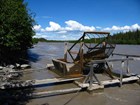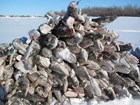Forty years after ANILCA was passed, the Alaska Region of the National Park Service is reflecting on the impact, legacy, and future of this unique legislation. Many Alaskans experience ANILCA as both a blessing and a burden. While tremendous hurdles have been overcome, there are many yet to be faced. This issue of Alaska Park Science provides a range of perspectives on ANILCA that we hope strikes a balance and reflects over four decades of varied experiences.
-
Article 1: Commemorating ANILCA at 40

ANILCA is the defining conservation law of Alaska. With a stroke of a pen, President Carter doubled the size of the National Park System. Alaskans experience the consequences of ANILCA as both a blessing and a burden. In this issue, we explore many of the facets and perspectives of ANILCA and what it means to Alaskans and to the National Park Service. Alaska Park Science 21(1), 2022. Read more
-
Article 2: ANILCA as an International Model for Conservation Legislation

ANILCA set a standard for how conservation legislation could be conceived at a large scale with space for a more complex relationship between protected ecosystems and the people who depend on them. Viewed in retrospect, ANILCA incorporated many aspects of what are currently considered best practices in conservation legislation. Alaska Park Science 21(1), 2022. Read more
-
Article 3: The Best Job in the World!

Field work consisting of river trips and overflights in the most scenic and remote areas of Alaska resulted in over 100 million acres of new or expanded national parks, refuges, and forests and the designation of over 3,200 river miles in 26 new wild and scenic rivers. Alaska Park Science 21(1), 2022 Read more
-
Yukon - Charley Rivers National Preserve
Article 4: The Power of a Few Words: How ANILCA Preserves the Human History of Alaska’s Public Lands

“Never before have we seized the opportunity to preserve so much of America’s natural and cultural heritage on so grand a scale.” ANILCA differed from other conservation legislation in its explicit inclusion of people and culture. People’s lives, both past and present, are intertwined in Alaska’s parklands. Alaska Park Science 21(1), 2022. Read more
-
Article 5: ANILCA, Navigability, and Sturgeon

Although ANILCA conserved millions of acres of land, it also included compromises to protect the interests of Alaskans in ways atypical in comparison to parks in other states. The use of waterways for commerce, access to resources, and enjoyment has a history of complex rights and jurisdictions. These ambiguities continue today, more than 40 years after ANILCA became law. Alaska Park Science 21(1), 2022. Read more
-
Article 6: ANILCA: A Perspective from Boots on the Ground

As might be expected from such a far-reaching piece of legislation, ANILCA is rife with ambiguities, contradictions, and complexities. These challenges are particularly acute for the National Park Service employees in the field charged with its implementation. Get an insider’s view of how ANILCA plays out on the ground. Alaska Park Science 21(1), 2022 Read more
-
Wrangell - St Elias National Park & Preserve
Article 7: Alaska Native Rights Champion Katie John Lived What She Believed: Honesty, Trust, Love, and Forgiveness

Katie John was a beloved Ahtna Athabascan Elder and champion of Alaska Native rights. Decades of her dedication and commitment secured Alaska Native traditional hunting and fishing rights. Alaska Park Science 21(1), 2022. Read more
-
Article 8: ANILCA and Subsistence: Perspectives from a Former Federal Subsistence Board Chair

ANILCA provides for subsistence use of Alaska’s wild resources. But the law is ambiguous and complex in its interpretation and implementation. Alaska Native subsistence rights and Alaska resident subsistence rights are sometimes at odds. This perspective explains the provisions and the shortcomings of subsistence management. Alaska Park Science 21(1), 2022. Read more
-
Article 9: Subsistence Harvest Monitoring of Pacific Salmon on the Kuskokwim River

Subsistence harvest of salmon is vital to the way of life for many Alaska Native people. The monitoring and management of salmon is of utmost importance to ensure continued availability of this critical resource. A decline in salmon populations can create food insecurity in rural Alaska communities. Alaska Park Science 21(1), 2022. Read more
-
Article 10: The Harvest and Use of Wild Resources by Communities Within or Near Northern Alaska Parklands

Customary and traditional harvests of wild resources provide for the nutritional, economic, spiritual, and cultural well-being of communities throughout Alaska. The National Park Service has the authority and responsibility to manage these uses on parklands. Comprehensive surveys reveal harvest and use patterns, providing information to maintain these critical resources and manage for the continuation of subsistence required under ANILCA. Alaska Park Science 21(1), 2022 Read more
